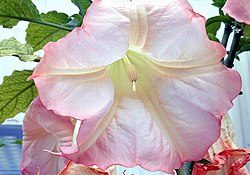
Back Solanaceae Afrikaans Nachtschattengewächse ALS باذنجانية Arabic باذنجانيه ARZ Solanaceae AST Quşüzümükimilər Azerbaijani Эт ҡарағаты һымаҡтар ғаиләһе Bashkir Паслёнавыя Byelorussian Пасьлёнавыя BE-X-OLD Картофови Bulgarian
| Solanaceae | |
|---|---|

| |
| A flowering Brugmansia suaveolens from the US Botanic Garden | |
| Scientific classification | |
| Kingdom: | Plantae |
| Clade: | Tracheophytes |
| Clade: | Angiosperms |
| Clade: | Eudicots |
| Clade: | Asterids |
| Order: | Solanales |
| Family: | Solanaceae Juss. |
| Type genus | |
| Solanum | |
| Subfamilies[3] | |
| Synonyms | |
| |
Solanaceae (/ˌsɒləˈneɪsi.iː, -ˌaɪ/),[5] commonly known as the nightshades, is a family of flowering plants in the order Solanales. It contains approximately 2,700 species, several of which are used as agricultural crops, medicinal plants, and ornamental plants. Many members of the family have high alkaloid contents, making some highly toxic, but many—such as tomatoes, potatoes, eggplants, and peppers—are commonly used in food.
Originating in South America, Solanaceae now inhabits every continent on Earth except Antarctica. After the K—Pg extinction event they rapidly diversified and have adapted to live in deserts, tundras, rainforests, plains, and highlands, and taken on wide range of forms including trees, vines, shrubs, and epiphytes. Nearly 80% of all nightshades are included in the subfamily Solanoideae, most of which are members of the type genus Solanum. Most taxonomists recognize six other subfamilies: Cestroideae, Goetzeoideae, Nicotianoideae, Petunioideae, Schizanthoideae, and Schwenkioideae, although nightshade taxonomy is still controversial. The genus Duckeodendron is sometimes placed in its own subfamily, Duckeodendroideae.
The high alkaloid content in some species has made them valuable for recreational, medicinal, and culinary use. The tobacco plant has been used for centuries as a recreational drug because of its high nicotine content. The tropanes in Atropa bella-donna can have pain-killing, relaxing, or psychedelic effects, making it a popular plant in alternative medicine, as well as one of the most toxic plants in the world. The presence of capsaicin in Capsicum species gives their fruits their signature pungency, which are used to make most spicy food products sold today. The potato, tomato, and eggplant, while not usually used for their alkaloids, also have an extensive presence in cuisine. Various food products like ketchup, potato chips, french fries, and multiple regional dishes are extremely commonly eaten around the world. Other nightshades are known for their beauty, such as the long, slender flowers of Brugmansia, the various colors of Petunia, or the spotted and speckled varietes of Schizanthus.
- ^ Särkinen, Tiina; Kottner, Sören; Stuppy, Wolfgang; Ahmed, Farah; Knapp, Sandra (12 February 2018). "A new commelinid monocot seed fossil from the early Eocene previously identified as Solanaceae". American Journal of Botany. 105 (1): 95–107. doi:10.1002/ajb2.1009. PMID 29532926.
- ^ Huang, Jie; et al. (10 July 2023). "Nuclear phylogeny and insights into whole-genome duplications and reproductive development of Solanaceae plants". Plant Communications. 4 (4). Bibcode:2023PlCom...400595H. doi:10.1016/j.xplc.2023.100595. PMC 10363554. PMID 36966360.
- ^ "Solanaceae". WFO Plant List.
- ^ "Duckeodendraceae". Global Biodiversity Information Facility. Retrieved 2025-01-25.
- ^ Lee, M. R. (June 2006). "The Solanaceae: foods and poisons". Journal of the Royal College of Physicians of Edinburgh. 36 (2): 162–169. doi:10.1177/1478271520063602021. ISSN 1478-2715. PMID 17153152. Archived from the original on 2023-03-09. Retrieved 2023-03-09.
© MMXXIII Rich X Search. We shall prevail. All rights reserved. Rich X Search